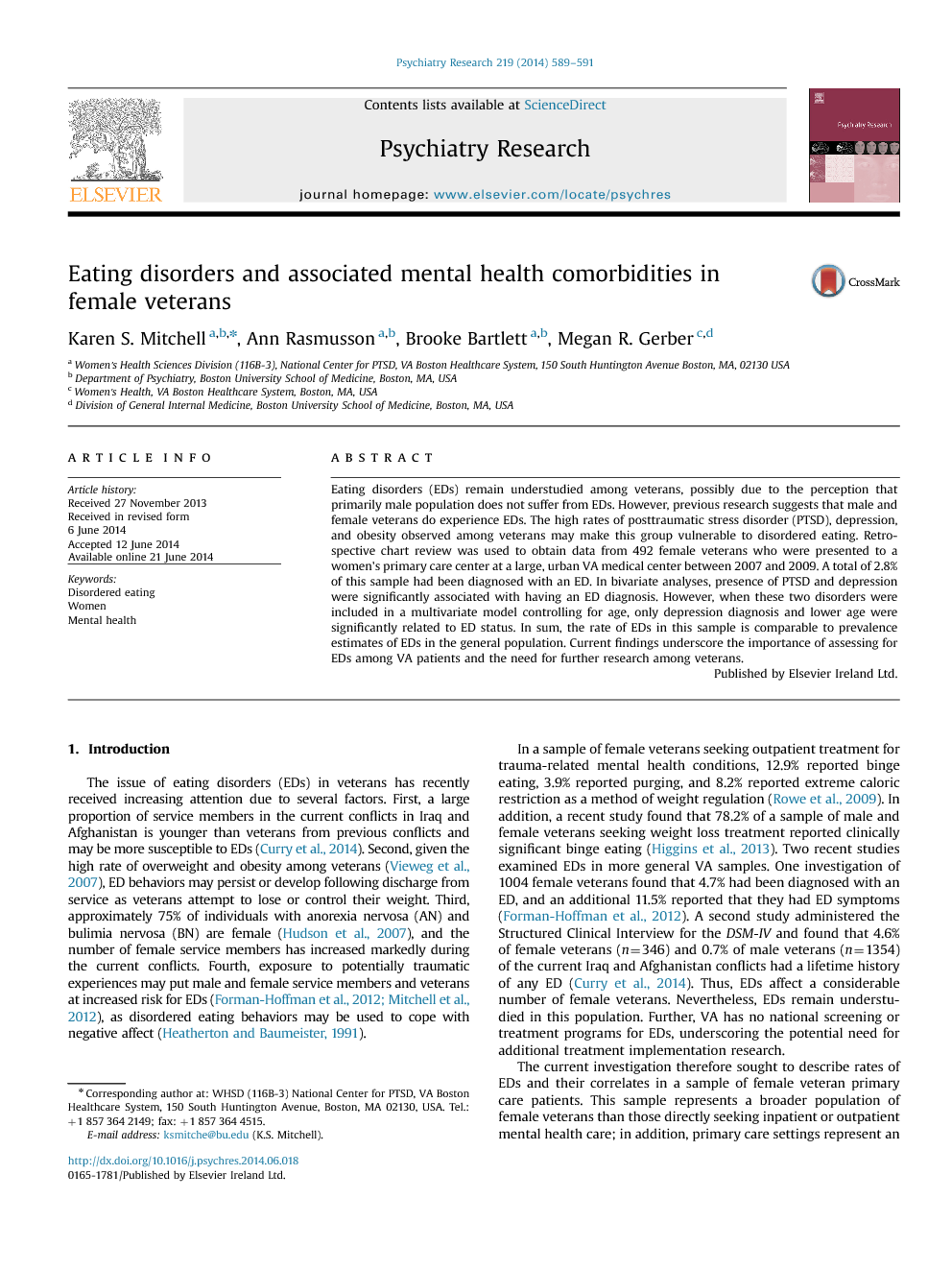Eating disorders (EDs) remain understudied among veterans, possibly due to the perception that primarily male population does not suffer from EDs. However, previous research suggests that male and female veterans do experience EDs. The high rates of posttraumatic stress disorder (PTSD), depression, and obesity observed among veterans may make this group vulnerable to disordered eating. Retrospective chart review was used to obtain data from 492 female veterans who were presented to a women׳s primary care center at a large, urban VA medical center between 2007 and 2009. A total of 2.8% of this sample had been diagnosed with an ED. In bivariate analyses, presence of PTSD and depression were significantly associated with having an ED diagnosis. However, when these two disorders were included in a multivariate model controlling for age, only depression diagnosis and lower age were significantly related to ED status. In sum, the rate of EDs in this sample is comparable to prevalence estimates of EDs in the general population. Current findings underscore the importance of assessing for EDs among VA patients and the need for further research among veterans.
The issue of eating disorders (EDs) in veterans has recently received increasing attention due to several factors. First, a large proportion of service members in the current conflicts in Iraq and Afghanistan is younger than veterans from previous conflicts and may be more susceptible to EDs (Curry et al., 2014). Second, given the high rate of overweight and obesity among veterans (Vieweg et al., 2007), ED behaviors may persist or develop following discharge from service as veterans attempt to lose or control their weight. Third, approximately 75% of individuals with anorexia nervosa (AN) and bulimia nervosa (BN) are female (Hudson et al., 2007), and the number of female service members has increased markedly during the current conflicts. Fourth, exposure to potentially traumatic experiences may put male and female service members and veterans at increased risk for EDs (Forman-Hoffman et al., 2012 and Mitchell et al., 2012), as disordered eating behaviors may be used to cope with negative affect (Heatherton and Baumeister, 1991).
In a sample of female veterans seeking outpatient treatment for trauma-related mental health conditions, 12.9% reported binge eating, 3.9% reported purging, and 8.2% reported extreme caloric restriction as a method of weight regulation (Rowe et al., 2009). In addition, a recent study found that 78.2% of a sample of male and female veterans seeking weight loss treatment reported clinically significant binge eating (Higgins et al., 2013). Two recent studies examined EDs in more general VA samples. One investigation of 1004 female veterans found that 4.7% had been diagnosed with an ED, and an additional 11.5% reported that they had ED symptoms (Forman-Hoffman et al., 2012). A second study administered the Structured Clinical Interview for the DSM-IV and found that 4.6% of female veterans (n=346) and 0.7% of male veterans (n=1354) of the current Iraq and Afghanistan conflicts had a lifetime history of any ED ( Curry et al., 2014). Thus, EDs affect a considerable number of female veterans. Nevertheless, EDs remain understudied in this population. Further, VA has no national screening or treatment programs for EDs, underscoring the potential need for additional treatment implementation research.
The current investigation therefore sought to describe rates of EDs and their correlates in a sample of female veteran primary care patients. This sample represents a broader population of female veterans than those directly seeking inpatient or outpatient mental health care; in addition, primary care settings represent an important point for VA care entry generally, and provide opportunities for both early detection and coordinated medical and behavioral treatment of EDs that may present but remain undertreated in the context of more apparent trauma-related disorders such as PTSD or depression. We hypothesized that rates of ED diagnoses would be similar to those in the general population and that rates of psychiatric disorders would be greater among women with EDs than those without EDs.


